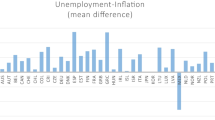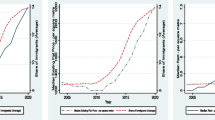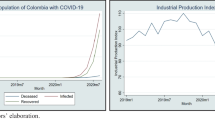Abstract
This paper extends the shift-contagion concept to housing price returns in order to examine co-movements between pairs of regional housing markets in the US. It associates nonlinearities of housing prices with the monetary policy criteria at disaggregate levels. The framework with Markov-switching volatility in Gravelle et al. (Journal of International Economics 68:409–423, 2006) is utilized to investigate housing contagion phenomena which are defined as the switches in the structural transmission of common shocks across regional housing markets. The empirical results suggest that interactions between regional and nationwide housing markets switch across low-volatility and high-volatility regimes of common shocks for the Northeast and the West whose housing price returns are nonlinear. In addition, there is the significantly time-varying interdependence between the West and each of the other three regional housing markets. The estimated indicator of the monetary policy effectiveness implies that monetary policies can be effective in the Northeast and the West because they are more closely linked with other regional housing markets in volatile phases which are subject to housing crises. Noticeably, the broken interrelationships between regional housing markets and real economies in the 2001 recession imply high vulnerability to housing bubbles for regional markets, while short-term monetary policies can be effective in stabilizing the housing market turmoil around 2007.


Similar content being viewed by others
Notes
For instance, Clayton et al. (2010), Goodman and Thibodeau (2008), Wheaton and Lee (2008), and Wheaton and Nechayev (2008) investigate housing markets at the metropolitan levels; Negro and Otrok (2007), Rapach and Strauss (2009) and Vansteenkiste (2007) address housing market issues at the state levels.
Fadiga and Wang (2009) suggest that in the long run, housing prices in the South and the Midwest follow dynamics of their own, while in the short run, only the housing prices in the South follow specific dynamics. They also suggest that the housing prices in the West show higher permanent variability and lower cyclical volatility. In addition, housing prices in the Northeast and the South show equal variability of permanent and transitory components, and the price in the Midwest shows higher cyclical disturbance volatility.
Clayton et al. (2010) consider three exogenous variables—labor employment rates, mortgage interest rates, and the stock index—in a bivariate panel VAR model in order to analyze housing markets in 114 metropolitan areas in the US during 1990–2002, and argue that supply elasticity is a noticeable feature of local housing markets. Ng and Moench (2011) incorporate the common components into a factor-augmented vector autoregression (FAVAR) in order to quantify the response of consumption to regional and national housing shocks, and to examine whether or not the impacts of these shocks are significantly different. Utilizing a dynamic factor model, Negro and Otrok (2007) introduce both the latent national factor and the local (state-level) factor in an attempt to investigate the relative importance of national and local components in house prices during 1986 to 2005. They argue that explanatory powers of two factors in terms of the fluctuation in house prices are different between the pre- and post-2001 periods. Vansteenkiste (2007) adopts a global VAR to address heterogeneity and interdependence across 31 state-level housing markets during 1986–2005. The study uses generalized impulse response functions (GIRFs) to examine responses to four different shocks which allow us to investigate the dynamics of the shock transmissions. They find that a 10 % shock to house prices in California and New York can have a strong spillover effect on house prices of other states, while a 10 % shock to the house price in Texas has a low impact on those of other states. These findings support a discrepancy in spillovers of housing prices across states.
Wheaton and Nechayev (2008) explore the main reasons for the sharp appreciation of US housing prices in 59 MSAs during 1998 to 2005. They find two common shocks which explain the price surge: the prevalent speculative housing investment (2nd home buying) and the active sub-prime mortgage market.
Goodman and Thibodeau (2008) propose that the appreciation of housing prices reflects significant spatial variation. They argue that some local housing markets, such as those in the East Coast and California, experience a greater rise in housing prices due to the inelastic supply of owner-occupied housing, which acts as an idiosyncratic shock in local housing markets.
Huang (2012) advocates that there is a broken linkage between the business cycle and the housing cycle during the period of 2001–2004. The housing cycle is represented by the estimated high-volatility regime of the US housing price.
The unemployment rate data are taken from US Department of Labor: Bureau of Labor Statistics, and they are available since 1976. Other than unemployment, the economic fundamentals which are discussed in the existing literature on housing markets consist of GDP(output), personal income, employment, housing rent, population(demographic factors), the construction cost, stock prices, and so on.
Groshen and Potter (2003) documented that the 2001 recession was followed by a period of “jobless recovery” during which job losses were permanent and employers spent longer time searching for skilled labors than before. Thus, regional unemployment rates are chosen to represent regional economic fundamentals in the analysis.
The Michigan Survey of Consumers separates the recent housing boom into two phases: the early-boom stage during 2002–2003 and the second stage during 2004–2005.
References
Case KE, Shiller RJ (2003) Is there a bubble in the housing market? Brookings PapEcon Act 2:299–362
Ceron J, Suarez J (2006) Hot and cold housing market: international evidence. CEMFI Working Paper No. 0603
Claessens S, Dornbusch R, Park YC (2001) Contagion: why crises spread and how this can be stopped. In: Claessens S, Forbes K (eds) International financial contagion. Kluwer, Boston
Clayton JF, Miller NG, Peng L (2010) Price-volume correlation in the housing market: causality and co-movements. J Real Estate Financ Econ 40:14–40
Fadiga ML, Wang YA (2009) A multivariate unobserved component analysis of US housing market. J Econ Financ 33:13–26
Forbes K, Rigobon R (2001a) Measuring contagion: conceptual and empirical issues. In: Claessens S, Forbes K (eds) International financial contagion. Kluwer, Boston, pp 43–67
Forbes K, Rigobon R (2001b) Contagion in Latin America: definitions, measurement, and policy implications. J Lat Am Carib Econ Assoc 1:1–35
Forbes K, Rigobon R (2002) No contagion, only interdependence: measuring stock market co-movements. J Finance 57:2223–2261
Fry JM (2009) Bubbles and contagion in English house prices. The University of Manchester, UK, Working paper
Ghosh C, Guttery RS, Sirmans CF (1998) Contagion and REIT stock prices. J Real Estate Res 16:389–400
Goodman AC, Thibodeau TG (2008) Where are the speculative bubbles in US housing market? J Hous Econ 17:117–137
Gravelle T, Kichian M, Morley J (2006) Detecting shift-contagion in currency and bond markets. J Int Econ 68:409–423
Groshen EL, Potter S (2003) Has structural change contributed to a jobless recovery? Current Issues in Economics and Finance 9, no. 8. Federal Reserve Bank of New York
Guo F, Chen CR, Huang YS (2011) Markets contagion during financial crisis: a regime-switching approach. Int Rev Econ Finance 20:95–109
Hasan MS, Taghavi M (2002) Residential investment, macroeconomic activity and financial deregulation in the UK: an empirical investigation. J Econ Bus 54:447–462
Himmelberg C, Mayer C, Sinai T (2005) Assessing high house prices: bubbles, fundamentals, and misperceptions. J Econ Perspect 19:67–92
Huang MC (2012) The role of people’s expectation in the recent US housing boom and bust. J Real Estate Financ Econ. doi:10.1007/s11146-011-9341-0
Kim SW, Bhattacharya B (2009) Regional housing prices in the USA: an empirical investigation of non-linearity. J Real Estate Financ Econ 38:443–460
King MA, Wadhwani S (1990) Transmission of volatility between stock markets. Rev Financ Stud 3:5–33
Lastrapes W, Potts T (2006) Durable goods and the forward-looking theory of consumption: estimates implied by the dynamic effects of money. J Econ Dyn Control 30:1409–1430
Masson P (1999) Contagion macroeconomic models with multiple. J Int Money Finance 18:587–602
Negro MD, Otrok C (2007) 99 Luftballons: monetary policy and the house price booms across US states. J Monet Econ 54:1962–1985
Ng S, Moench E (2011) A hierarchical factor analysis of US housing market dynamics. Econ J 14:C1–C24
Oikarinen E (2006) The diffusion of housing price movements from center to surrounding areas. J Hous Res 15:3–28
Rapach DE, Strauss JK (2009) Differences in housing price forecastability across US states. Int J Forecast 25:351–372
Riddel M (2011) Are housing bubbles contagious? A case study of Las Vegas and Los Angeles home prices. Land Econ 87:126–144
Rigobon R (1999) Does contagion exist? The Investment Strategy Pack, Banking Department of the BIS
Rigobon R (2001) Contagion: How to measure it? In: Edwards S, Frankel J (eds) Preventing currency crises in emerging markets. University of Chicago Press, pp 269–334
Rigobon R (2003a) Identification through heteroskedasticity. Rev Econ Stat 85:777–792
Rigobon R (2003b) On the measurement of the international propagation of shocks: is the transmission stable? Journal of International Economics 61:261–283
Roche MJ (2001) The rise in house prices in Dublin: bubble, fad or just fundamentals. Econ Model 18:281–295
Schaller H, van Norden S (1997) Fads or bubbles? Bank of Canada Working Paper No. 97-2
Stevenson S (2004) House price diffusion and inter-regional and cross-border house price dynamics. J Prop Res 21:301–320
Vansteenkiste I (2007) Regional housing market spillover in the US: lessons from regional divergences in a common monetary policy setting. ECB Working Paper 708
Vargas-Silva C (2008) Monetary policy and the US housing market: A VAR Analysis Imposing Sign Restrictions. J Macroecon 30:977–990
Wheaton WC, Lee NJ (2008) Do housing sales drive housing prices or the converse. MIT Dep. of Economics Working Paper No. 08-01
Wheaton WC, Nechayev G (2008) The 1998–2005 housing ‘bubble’ and the current ‘correction’: what’s different this time. J Real Estate Res 30:1–26
Wheeler M, Chowdhury A (1993) The housing market, macroeconomic activity and financial innovation: an empirical analysis of US data. Appl Econ 25:1385–1395
Xu T, Han Y, Yang J (2012) US Monetary policy surprises and mortgage rates. Real Estate Econ. doi:10.1111/j.1540-6229.2011.00325.x
Author information
Authors and Affiliations
Corresponding author
Rights and permissions
About this article
Cite this article
Huang, M. Monetary policy implications of housing shift-contagion across regional markets. J Econ Finan 38, 589–608 (2014). https://doi.org/10.1007/s12197-012-9237-8
Published:
Issue Date:
DOI: https://doi.org/10.1007/s12197-012-9237-8
Keywords
- Housing Shift-Contagion
- Regional Housing Market
- Monetary Policy
- Markov-Switching
- Structural Transmission
- Nonlinear




